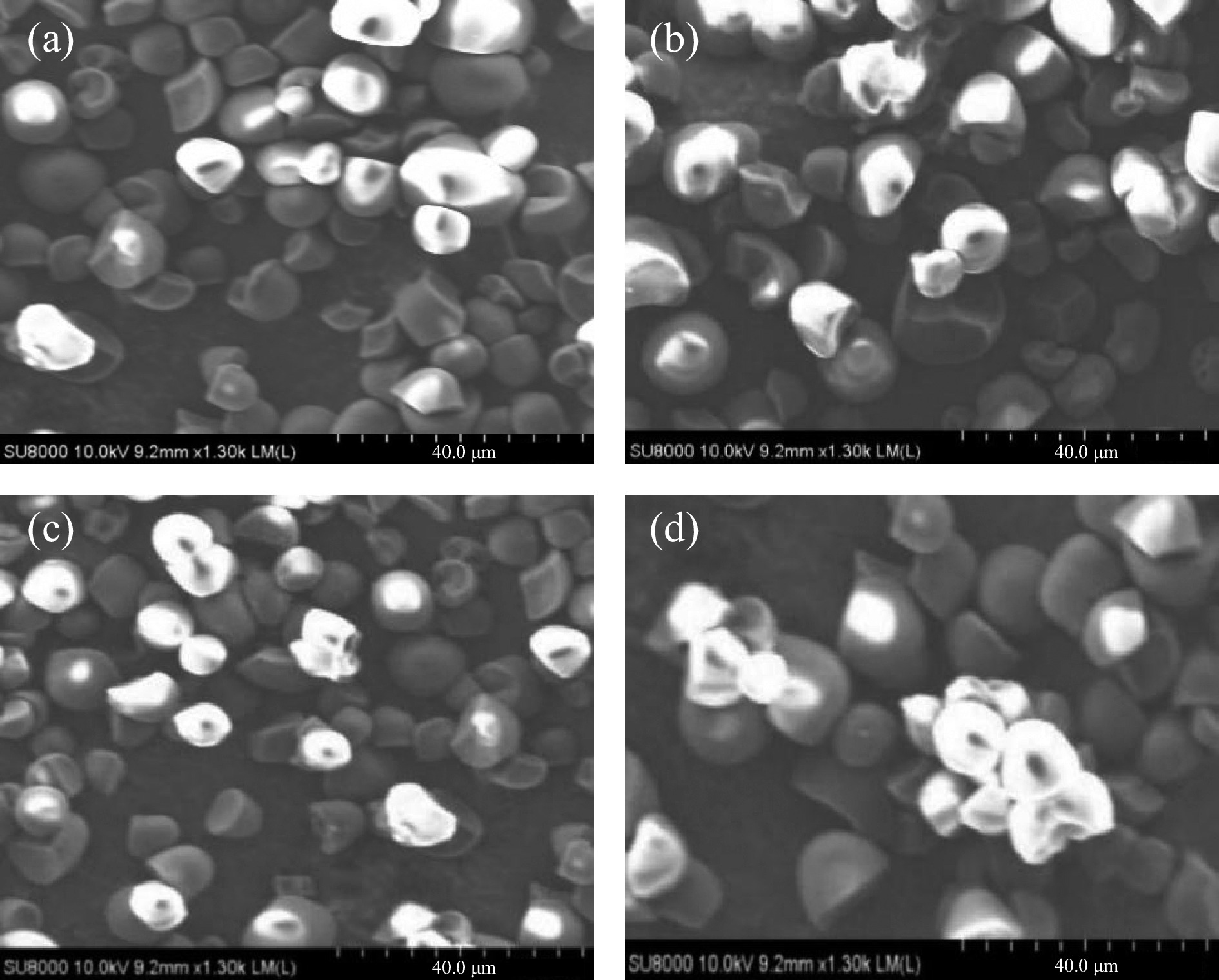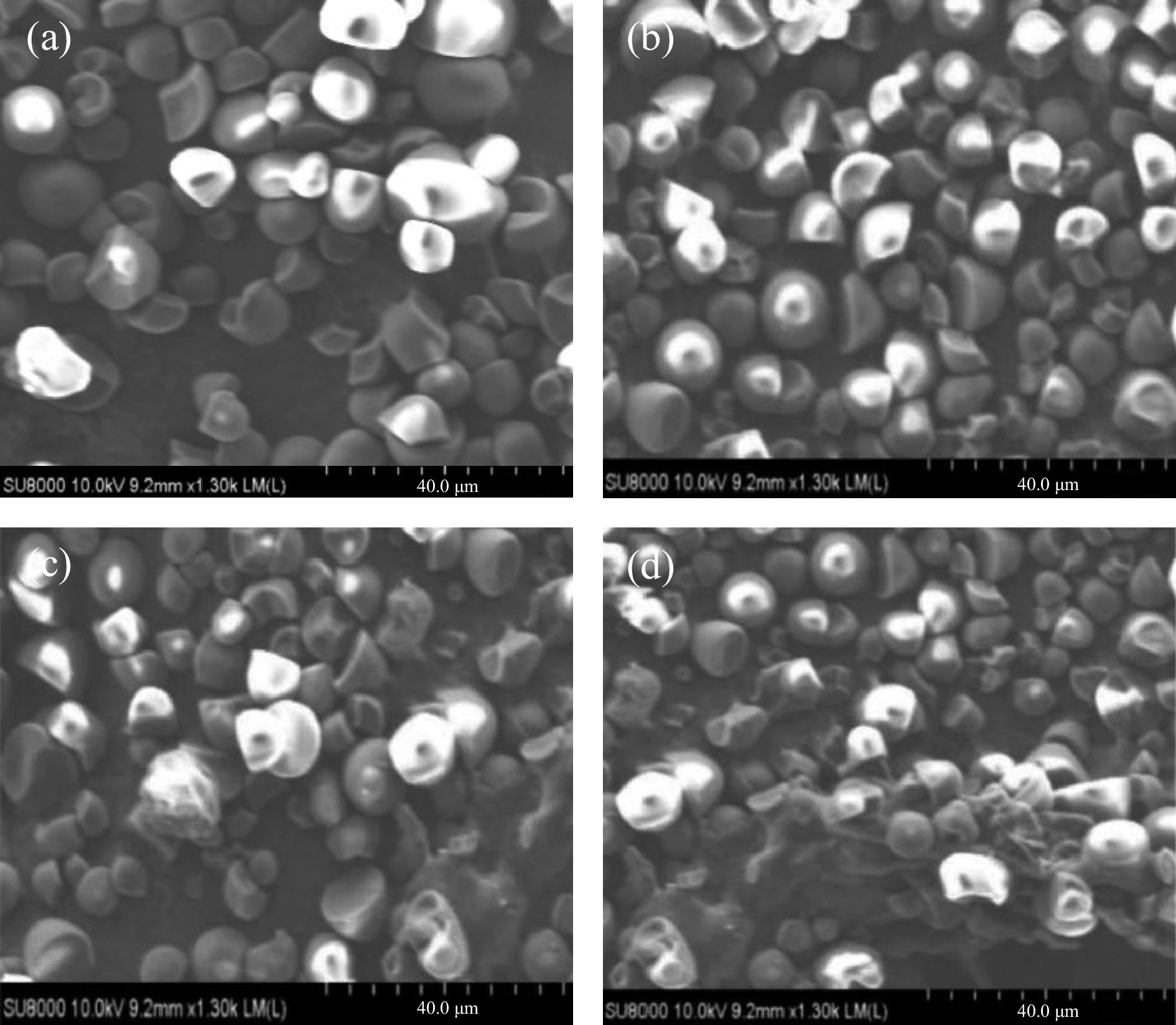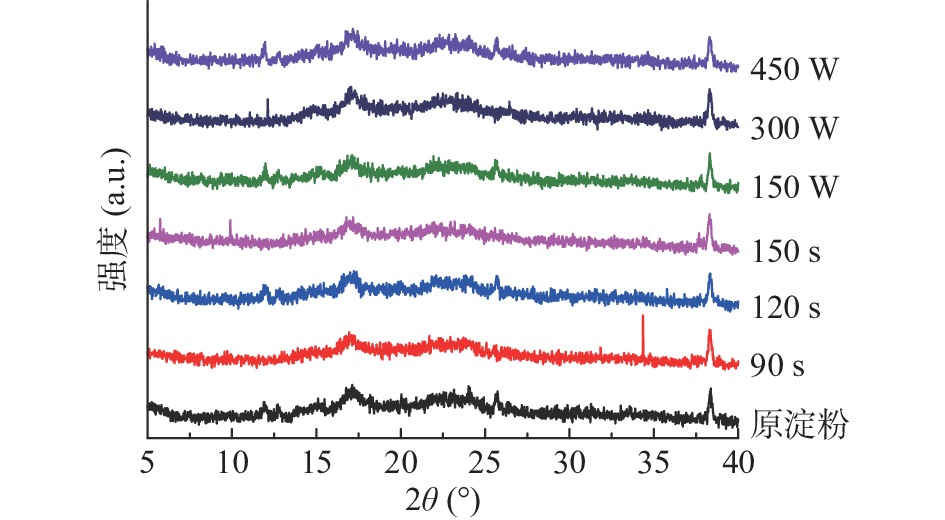Effect of Microwave Treatment on the Physicochemical and Digestive Properties of Loquat Kernel Starch
-
摘要: 为研究微波处理枇杷核淀粉理化及其消化性能的影响,以X射线衍射仪(XRD)、流变仪、扫描电子显微镜(SEM)以及Englyst法为分析手段,研究了不同微波时间和功率下枇杷核淀粉的晶体结构、糊化特性、颗粒形貌、溶解度、膨胀力、透明度和消化性能等的变化。结果表明:微波加热时间(90、120、150 s)和功率(150、300、450 W)不同,对淀粉的影响程度也不同。微波处理对枇杷核淀粉的晶型没有影响,仍为C型;随着微波加热时间和功率的提高,枇杷核淀粉的糊化特性(峰值黏度、谷值黏度、终值黏度)、溶解度与膨润力呈现逐渐上升的趋势,且枇杷核淀粉表面形貌发生一定变化。枇杷核原淀粉的快消化淀粉(RDS)、慢消化淀粉(SDS)、抗性淀粉(RS)的含量分别为9.45%、6.75%、83.8%,随着微波加热时间和功率的增加,RDS的含量增加至12.03%和13.45%,而SDS的含量下降至2.93%和2.03%,结果表明微波处理能够在一定程度上改变枇杷核淀粉的消化性。微波处理能够有效改变枇杷核淀粉结构和理化性质,提高淀粉体外消化速率。Abstract: To investigate the effect of microwave treatment on the physicochemical and digestive properties of loquat kernel starch, the changes of crystal structure, gelatinization characteristics, particle morphology, solubility, swelling force, transparency and digestibility of loquat kernel starch under different heating time and power of microwave treatment was studied by using the X-ray diffraction (XRD), rheometry, scanning electron microscopy (SEM), and Englyst methods. It was found that the difference in the heating time (90, 120, 150 s) and power of microwave treatment (150, 300, 450 W) revealed the different effect on the properties of loquat kernel starch. The crystal form of loquat kernel starch, which remained C type, was not affected by the microwave treatment. With the increase of microwave heating time and power, the gelatinization characteristics (peak viscosity, valley viscosity, final viscosity), solubility, and swelling power of loquat kernel starch gradually increased, and the surface morphology of loquat kernel starch was partly changed. The contents of fast digestible starch (RDS), slow digestible starch (SDS) and resistant starch (RS) of loquat kernel primary starch were 9.45%, 6.75%, and 83.8%, respectively. The contents of RDS increased to 12.03% and 13.45% with the increase of microwave heating time and power, respectively, whereas the content of SDS decreased to 2.93% and 2.03% under the same treatment, which indicated that the microwave treatment could considerably change the digestibility of loquat kernel starch. Microwave treatment could effectively change the structure and physicochemical properties of loquat kernel starch, and improve in vitro digestion rate of starch.
-
枇杷是蔷薇科草本植物枇杷(Eriobotrya japonica Lindl.)的果实,原产于中国东南部[1]。目前我国已经是世界上主产枇杷的国家,产区主要集中于福建、江苏、云南和四川等地方。枇杷为我国传统药食同源植物,长期以来一直在人们的日常生活中扮演着重要角色。枇杷叶、花、果实和枇杷核的功效、成分、品种与含量、生物活性等被逐步揭示[2]。枇杷核的味道比较苦涩,但是却有改善咳嗽、痰多等症状的功效。枇杷核是枇杷罐头的副产品,含有较多的淀粉,在食品、材料加工等方面具有较好的发展前景[3],但很多人吃完枇杷以后,直接将枇杷核丢弃,这不仅造成了环境的污染,还导致了资源的极大浪费。
微波加热有时间短、效率高、卫生、方便、节能等优点,能够有效改善食品的营养和风味[4]。近年来,有部分研究者对辐照淀粉的物理、化学等性质及结构进行了研究。结果表明,微波处理技术会导致淀粉的颗粒外观形态及结晶结构被破坏,从而对淀粉的理化性质造成影响[5-7]。蒲华寅等[8]研究表明微波处理均未改变淀粉的晶型,但随着微波时间的延长,淀粉相对结晶度和短程有序度均呈下降趋势,同时,微波可引起淀粉降解,导致处理后更易老化,进而引起淀粉糊透明度的降低。李晓玺等[9]研究表明高链玉米淀粉经微波改性后,颗粒形貌发生改变,表面出现凹凸、小孔,大部分淀粉颗粒发生破损、崩裂。目前国内外针对枇杷核淀粉的研究相对较少,林国荣等[10]研究枇杷核淀粉存在一个初始膨胀阶段和迅速膨胀阶段,为典型的二段膨胀过程,属限制型膨胀淀粉,从而影响枇杷核淀粉的开发利用。本文通过微波处理枇杷核淀粉,研究了不同微波条件处理枇杷核淀粉后的颗粒形貌、晶体结构、糊化特性、溶解度和膨胀力、透明度以及体外模拟消化等指标,以期得到消化特性良好的枇杷核淀粉,有助于枇杷核被更加充分地开发和利用。
1. 材料与方法
1.1 材料与仪器
市售枇杷 2022年3月购买于云南省蒙自市的果实;亚硫酸钠、柠檬酸、无水醋酸钠、冰醋酸、无水乙醇、酒石酸钾钠、3,5-二硝基水杨酸、氢氧化钠、苯酚 均为分析纯,国药集团化学试剂有限公司;α-淀粉酶(10000 U/g)、糖化酶(100000 U/g) 上海晨易生物科技有限公司。
DGG-9123A热恒温鼓风干燥箱 上海森信实验仪器有限公司;KQ-600DE超声波清洗器 昆山市超声仪器有限公司;SU8010扫描电子显微镜 日本日立;TENSOR27傅立叶变换红外光谱仪 德国Bruker公司;DSC214差示扫描量热仪 德国耐驰;XRD-6100 X射线衍射仪 日本岛津;Viscotester iQ智能流变仪 美国Thermo Scientific HAAKE 。
1.2 实验方法
1.2.1 枇杷核淀粉的制备
取枇杷果实中新鲜的枇杷核,称取一定量枇杷核,将枇杷核清洗干净后去皮,配制质量分数为0.15%的亚硫酸钠的溶液并用0.1%柠檬酸调节至pH6.0,按照枇杷核和水1:2(g/g)的比例加入以上溶液,放入压榨机中压榨,压榨过后浆液用滤网进行过滤,使枇杷核溶液的浆、渣分离,将滤渣再次按照以上比例加蒸馏水,重复以上步骤3次,使枇杷核中的淀粉完全浸提出来。将滤液放置1 h,倒掉上层清液,将沉淀水洗,以4500 r/min离心10 min,倒掉上层清液,沉淀去掉上层部分,在40 ℃的干燥箱中干燥10 h,干燥之后的枇杷核淀粉经研磨成为细粉,过80目筛,得到枇杷核粗淀粉备用[10]。
1.2.2 微波处理枇杷核淀粉
微波处理参考蒲华寅等[8]的方法并进行适当修改。分别称取30 g枇杷核淀粉六份,定容到100 mL,配制成质量分数为30%的淀粉乳。微波功率150 W,微波加热时间分别为90、120、150 s;微波加热时间90 s,微波功率分别为150(10%火力)、300(20%火力)、450 W(30%火力),冷却后以4500 r/min离心10 min,去掉上层清液,取沉淀,40 ℃干燥箱干燥10 h,粉碎,过80目筛,得到的淀粉备用。
1.2.3 淀粉的颗粒形貌观察
取不同微波处理条件下少许枇杷核淀粉,对已经完全烘干的淀粉进行镀金处理后,置于高分辨场发射扫描电镜样品室中,电子枪加速电压为10 kV,放大倍数1000,观察不同条件下微波处理的淀粉的形貌差异,对其形态结构进行对比和分析。
1.2.4 淀粉的晶体结构测定
称取1.0 g枇杷核淀粉,放置在样品板上,用玻璃片将粉末在样品板凹槽中压实,直到粉末和样品板呈同一水平面,将样品板放入衍射仪中,使用X-射线衍射仪分析枇杷核淀粉的晶体结构。测定条件:电压40 kV,电流30 mA,扫描速度2.0°/min,扫描范围5º~−40º(2θ)[11]。
1.2.5 淀粉糊化特性的测定
称取3.0 g枇杷核淀粉于烧杯中,配成质量分数为6.0%的淀粉乳,放在50 ℃的水浴锅里面,用玻璃棒搅拌,在50 ℃时保持3 min,将粘度计的转速调到30 r/min,并且记录其黏度变化,之后将水浴锅的温度调至95 ℃,期间边搅拌边测定淀粉乳的黏度变化,每分钟记录一次,当温度达到95 ℃时,保持5 min,并且记录黏度变化,之后将温度降低至50 ℃,得到样品的温度、黏度、时间变化,每个样品测定3次,得到样品的峰值黏度、回生值、终值黏度、谷值黏度。
1.2.6 淀粉的溶解度和膨胀力测定
称取1.5 g枇杷核淀粉于50 mL容量瓶,加水定容,在90 ℃水浴锅里面充分糊化反应1 h,冷却。4500 r/min离心15 min,倾倒出表层清液到已经烘干的培养皿中,倾倒溶液之前先记录烘干后的培养皿的质量,之后将倒出来的溶液放在110 ℃烘箱内烘至恒重。称取被溶解的淀粉质量记为m0,称取离心沉淀物的质量即为膨胀的淀粉的质量记为m1,计算的公式为:
式中:Q:溶解度;S:膨胀力;m0:上清液蒸干至恒重的质量,g;m1:离心后沉淀物的质量,g;m:淀粉总质量,g。
1.2.7 淀粉透明度的测定
称取1.0 g枇杷核淀粉于烧杯中,配制成质量分数为1.0%的淀粉溶液,在沸水浴中加热、并且搅拌1 h,冷却至室温,振荡均匀后,以去离子水为空白对照,于620 nm波长下测定枇杷核淀粉糊的透光率T(%),记录数据。
1.2.8 淀粉消化特性的测定
1.2.8.1 葡萄糖标准曲线的制作
准备6根试管,分别标记为0~5号管,分别添加0、0.1、0.2、0.3、0.4、0.5 mL的1 mg/mL葡萄糖标准溶液,然后依次添加蒸馏水0.5、0.4、0.3、0.2、0.1、0 mL,在每根管中加0.5 mL DNS试剂,在沸水浴中加热5 min,凉水冷却,最后每管里加入4.0 mL蒸馏水,零号管调零,在540 nm处测定其吸光度,绘制标准曲线。
1.2.8.2 样品中葡萄糖含量的测定
参考Englyst等[12]方法并稍作修正。称取0.2 g枇杷核淀粉,加入20 mL 0.2 mol/L的醋酸钠缓冲溶液,在沸水浴中加热25 min,冷却至室温,于37 ℃水浴锅加热10 min,随后添加1 mL 3000 U/mL α-淀粉酶和4 mL 2500 U/mL糖化酶,在水浴锅里进行水解作用,最后依次在0、20、120 min取样0.5 mL,并加4.5 mL无水乙醇溶液,将溶液在4000 r/min的条件下离心10 min,取上层清液,用DNS法测定试样中的葡萄糖含量,并且计算出试样中的快速消化淀粉(RDS)、慢消化淀粉(SDS)、抗性淀粉(RS)含量。
计算公式如下:
式中:G20:经过20 min的淀粉酶水解产生的葡萄糖含量,mg;G120:经过120 min淀粉酶水解后产生的葡萄糖含量,mg;G0:在淀粉酶水解前,试样中的葡萄糖含量,mg;m:样品质量,mg。
1.3 数据处理
实验数据3次重复,数据以均值±标准差表示;所有数据应用Excel软件、SPSS软件和Origin 2020b软件进行处理和分析。显著性分析采用Duncan检验,P>0.05判定为变化不显著,P<0.05判定为变化显著。
2. 结果与分析
2.1 不同微波处理条件对枇杷核淀粉颗粒形貌的影响
图1为扫描电镜观察到的不同微波处理时间枇杷核淀粉的颗粒形貌。图1a为原淀粉的颗粒形貌,可以看出,枇杷核淀粉的形状不规则,大多数呈圆形或者半圆形[10],淀粉颗粒表面光滑。由图1b、c可以看出,微波加热时间段后,淀粉的形状没有发生明显改变,随着微波加热时间的增加,团聚现象增加,归因于微波加热过程中产生的热量使颗粒聚集成团簇状[13],可能是由于直链淀粉的逸出和支链淀粉膨胀,使其黏附性和相互作用力增强[14]。
图2为不同微波加热功率条件下淀粉的颗粒形貌图。由图2(a)、(b)两图可以看出,加热功率为150 W时,淀粉形貌没有明显变化。图2d表示原淀粉在450 W处理后,淀粉表面出现了凹凸不平的裂痕,部分淀粉的形状颗粒也开始破裂,呈现出部分糊化结构;图2c为微波加热功率300 W,部分淀粉的颗粒发生了变化,其中有部分淀粉的颗粒表面开始发生颗粒的聚集,形状有所改变。由此可见,提高微波加热的功率对淀粉的颗粒形貌有一定影响,微波处理使淀粉表面出现了裂痕,与文献报道的结果相一致[15]。
2.2 不同微波处理条件对枇杷核淀粉晶体结构的影响
根据淀粉的X-射线衍射图谱的不同,可以将淀粉的晶体结构A型、B型、C型[16],A型淀粉的图谱在15°、17°、18°、23°左右会有较明显的衍射峰;B型淀粉在5°、17°、22°、24°处有衍射峰;C型是A型与B型的组合类型[17]。由图3可知,枇杷核淀粉在2θ为13°、17°、25.6°、38°处都产生了比较明显的衍射峰,由此可初步判定枇杷核淀粉是A、B型的组合类型,属于C型淀粉[3]。将原淀粉和其他经过微波处理的淀粉相比较,从衍射峰上看,每个淀粉样品在17°、38°时都有衍射峰,经过相同功率微波处理90、150 s,以及经过相同时间微波功率300 W处理的淀粉,在25.6°的衍射角处没有出现明显的衍射峰,可能是由于微波处理破坏枇杷核淀粉的结构,使其结晶区被破坏,相对结晶度降低,但是没有在其他位置出现强的吸收峰,表明微波处理并未改变枇杷核淀粉的晶型[18]。
2.3 不同微波处理条件对枇杷核淀粉糊化特性的影响
表1是测定不同微波处理条件下枇杷核淀粉的黏度变化,结果用平均值±标准差表示。由表1可知,在相同的微波火力下,微波加热处理淀粉90、120、150 s后,淀粉的各个黏度均明显增加,说明微波加热导致淀粉的热稳定性变差,比未经处理的原淀粉更易发生老化。同时,随着微波加热时间的增加,淀粉的黏度和回生值升高,微波加热提高了淀粉的老化程度,可能是因为微波加热影响了枇杷核淀粉的晶体结构,使淀粉的结晶结构变得松散,链之间的相互作用力减弱[15]。
表 1 不同微波处理对枇杷核淀粉糊化特性的影响Table 1. Effect of different microwave treatment on gelatinization properties of loquat kernel starch样品 峰值黏度(mPa·s) 谷值黏度(mPa·s) 终值黏度(mPa·s) 回生值(mPa·s) 原淀粉 80.3±7.9b 46.0±5.9b 136.7±36.0b 90.7±41.8a 90 s 99.3±6.4ab 79.8±8.2a 172.9±15.8ab 93.1±8.5a 120 s 105.3±12.4ab 86.2±10.3a 185.6±8.0ab 99.3±17.4a 150 s 121.1±14.0a 87.5±5.2a 206.4±8.1a 118.9±5.2a 150 W 158.01±24.8a 74.2±3.4b 182.3±16.0ab 108.1±12.6a 300 W 169.6±13.2a 89.0±7.1a 199.8±1.8a 110.8±6.8a 450 W 185.1±14.8a 91.5±4.9a 211.5±2.9a 117.9±0.8a 注:同列不同小写字母表示差异显著(P<0.05);表2、表3同。 由表1可知,经过功率150、300、450 W微波加热相同时间之后,淀粉的黏度和回生值均呈上升趋势,微波处理使淀粉颗粒结构疏松,分子链中糖苷键被断开,形成大量短直链淀粉,这些短直链淀粉由于分子量较小容易定向排列,形成微晶结构,从而导致了回生值的增加[19]。峰值黏度与原淀粉相比发生较大的提高,微波加热对淀粉的糊化特性产生影响,改变了淀粉的老化程度。随着微波处理的时间和火力的提高,淀粉的老化程度也逐渐提高。
2.4 不同微波处理条件对枇杷核淀粉的溶解度和膨胀力的影响
溶解度和膨胀力反映了淀粉和水之间相互作用的大小[20]。由表2中可以看出,微波加热的时间和功率对淀粉的溶解度和膨胀力会产生一定的影响。由表2可知,随着微波加热时间的增加,淀粉的溶解度和膨胀力也显著增加(P<0.05),这表明枇杷核淀粉的溶解度变化对于微波较敏感,不同处理可得到不同溶解度的淀粉[21]。由表2可知,微波加热90 s,处理功率分别为150、300、450 W,与原淀粉相比,淀粉的溶解度随着微波功率的提高而显著增加(P<0.05),而膨胀力随着微波功率的提高先增加后减少。因为微波处理使枇杷核淀粉颗粒内部部分直链淀粉降解,并引起淀粉内部结构重新排列,使得淀粉分子内部键能变弱,使淀粉的致密化程度降低,颗粒内部的淀粉分子易溶出,增加淀粉颗粒与水结合能力,所以使淀粉得溶解度与膨润力提高[22]。
表 2 不同微波处理对枇杷核淀粉溶解度和膨胀力的影响Table 2. Effect of different microwave treatment on solubility and swelling power of loquat kernel starch样品 溶解度(%) 膨胀力(%) 原淀粉 4.2±0.0d 17.5±0.1c 90 s 4.8±0.0c 19.7±0.1b 120 s 6.1±0.0b 19.1±0.1b 150 s 6.3±0.0a 20.0±0.1a 150 W 5.3±0.1c 18.9±0.1b 300 W 5.8±0.0b 17.9±0.1b 450 W 6.6±0.0a 17.9±0.2b 2.5 不同微波处理条件对枇杷核淀粉透明度的影响
淀粉的透明度是淀粉吸附水分的重要指标,随着淀粉的分散程度的增大,其透明度也随之提高。另外,淀粉的结构及分子链长度也会影响淀粉的透明度[23]。由表3可知,微波加热不同时间对淀粉的透光率产生了一定的影响,枇杷核淀粉经微波处理后淀粉糊的透光率均高于原淀粉;随着微波时间延长,淀粉短时间微波处理后其透过率先增大后随时间延长而减小。表明微波处理破坏了淀粉的结构,提高了淀粉和水的结合能力,从而增加了淀粉的透明度。
表 3 不同微波处理对枇杷核淀粉透光率的影响Table 3. Effect of different microwave treatment on the transmittance of loquat kernel starch样品 透光率(%) 原淀粉 57.1±0.5b 90 s 58.5±0.3a 120 s 58.3±0.4ab 150 s 57.9±0.7ab 150 W 57.4±0.4ab 300 W 56.8±0.7b 450 W 50.9±0.5b 由表3可知,在加热时间相同的前提下,随着微波加热功率的提高,淀粉的透光率逐渐降低。淀粉在微波处理功率为450 W时透明度下降趋势比较明显,由于微波辐射会使淀粉支链发生降解,从而形成更多的直链淀粉,而直链淀粉分子量小,易于相互凝聚而使得淀粉发生回生,造成淀粉颗粒的持水能力下降,从而导致透光率下降(P<0.05)。说明微波处理的火力增加对淀粉的透明度影响较大,会降低淀粉的稳定性[8]。
2.6 不同微波处理条件对枇杷核淀粉消化特性的影响
由表4可知,原淀粉的RDS含量为9.45%,SDS为6.75%,RS为83.80%,其中抗性淀粉的含量最高,在人体消化道内基本不消化吸收抗性淀粉,在胃肠道中滞留时间比较长[24]。微波加热时间越长,RDS含量增加,SDS减少,RS减少,相对于原淀粉,微波处理后RS含量均有所提高,因为微波使温度升高,有利于重排行为的进行,所以随温度升高,RS升高,但过高的温度容易引起淀粉的糊化和焦化,反而降低RS含量。在一定条件下,淀粉分子在微波作用下的重排需要一定时间,延长反应时间,有利于重排的进行,但当微波作用达到一定时间时,重排达到平衡状态,再延长反应时间对RS含量影响不大,而且延长反应时间,可能导致微波淀粉颗粒中晶体结构的破坏,反而不利于RS提高[25-27]。微波加热时间为150 s时,淀粉的RDS含量最高达12.03%,可能是微波加热使淀粉的颗粒表面出现裂痕,从而使酶更加容易进入到淀粉颗粒的内部,使RDS含量增加[28]。
表 4 不同微波处理对枇杷核淀粉消化特性的影响Table 4. Effect of different microwave treatment on digestibility of loquat kernel starch样品 RDS(%) SDS(%) RS(%) 原淀粉 9.45 6.75 83.80 90 s 9.45 3.35 87.20 120 s 10.35 2.90 86.75 150 s 12.03 2.93 85.04 150 W 10.05 2.50 87.45 300 W 10.13 3.83 86.05 450 W 13.45 2.03 84.53 由表4可见,随着微波加热功率的提高,淀粉的RDS含量呈上升趋势,SDS含量先增加再减少,RS减小,但RS含量都高于原淀粉。微波加热功率为450 W时,淀粉的RDS含量最高达13.45%,总之,微波处理对淀粉的慢消化淀粉影响最明显,减小的趋势比较大。RDS含量变化是因为较高的温度将淀粉细胞壁破坏,使得淀粉与蛋白质、纤维等物质的作用减弱,增大了消化酶与样品的接触面积[29],提高了淀粉的易消化程度。
3. 结论
微波加热时间和功率的不同,对淀粉的影响程度也不同。微波处理对枇杷核淀粉的晶型没有影响,仍为C型;随着微波加热的时间和功率的提高,枇杷核淀粉的糊化特性(峰值黏度、谷值黏度、终值黏度)、溶解度与膨润力呈现逐渐上升趋势,且枇杷核淀粉表面形貌发生一定变化。枇杷核原淀粉的快消化淀粉(RDS)、慢消化淀粉(SDS)、抗性淀粉(RS)的含量分别为9.45%、6.75%、83.8%,经过微波处理加热时间和功率增加,RDS的含量增加至12.03%和13.45%,而SDS的含量下降至2.93%和2.03%,说明微波处理能够在一定程度上改变枇杷核淀粉的消化性。这些研究结果表明,微波处理可以改变枇杷核淀粉的结构,从而改变枇杷核淀粉的某些性质,可以作为一种前处理手段以满足某些加工生产的需求,同时也为微波处理枇杷核淀粉的结构性质变化提供了一定的理论依据。微波处理改性淀粉的研究较多,但微波处理改性淀粉的机理仍需深入研究。微波处理过程中,食品中存在的其他组分与淀粉的相互作用、这些相互作用对淀粉质构特性的影响和微波处理改性淀粉的应用等也有待进一步研究。
-
表 1 不同微波处理对枇杷核淀粉糊化特性的影响
Table 1 Effect of different microwave treatment on gelatinization properties of loquat kernel starch
样品 峰值黏度(mPa·s) 谷值黏度(mPa·s) 终值黏度(mPa·s) 回生值(mPa·s) 原淀粉 80.3±7.9b 46.0±5.9b 136.7±36.0b 90.7±41.8a 90 s 99.3±6.4ab 79.8±8.2a 172.9±15.8ab 93.1±8.5a 120 s 105.3±12.4ab 86.2±10.3a 185.6±8.0ab 99.3±17.4a 150 s 121.1±14.0a 87.5±5.2a 206.4±8.1a 118.9±5.2a 150 W 158.01±24.8a 74.2±3.4b 182.3±16.0ab 108.1±12.6a 300 W 169.6±13.2a 89.0±7.1a 199.8±1.8a 110.8±6.8a 450 W 185.1±14.8a 91.5±4.9a 211.5±2.9a 117.9±0.8a 注:同列不同小写字母表示差异显著(P<0.05);表2、表3同。 表 2 不同微波处理对枇杷核淀粉溶解度和膨胀力的影响
Table 2 Effect of different microwave treatment on solubility and swelling power of loquat kernel starch
样品 溶解度(%) 膨胀力(%) 原淀粉 4.2±0.0d 17.5±0.1c 90 s 4.8±0.0c 19.7±0.1b 120 s 6.1±0.0b 19.1±0.1b 150 s 6.3±0.0a 20.0±0.1a 150 W 5.3±0.1c 18.9±0.1b 300 W 5.8±0.0b 17.9±0.1b 450 W 6.6±0.0a 17.9±0.2b 表 3 不同微波处理对枇杷核淀粉透光率的影响
Table 3 Effect of different microwave treatment on the transmittance of loquat kernel starch
样品 透光率(%) 原淀粉 57.1±0.5b 90 s 58.5±0.3a 120 s 58.3±0.4ab 150 s 57.9±0.7ab 150 W 57.4±0.4ab 300 W 56.8±0.7b 450 W 50.9±0.5b 表 4 不同微波处理对枇杷核淀粉消化特性的影响
Table 4 Effect of different microwave treatment on digestibility of loquat kernel starch
样品 RDS(%) SDS(%) RS(%) 原淀粉 9.45 6.75 83.80 90 s 9.45 3.35 87.20 120 s 10.35 2.90 86.75 150 s 12.03 2.93 85.04 150 W 10.05 2.50 87.45 300 W 10.13 3.83 86.05 450 W 13.45 2.03 84.53 -
[1] 刘国强, 林志清, 林文忠, 等. 我国枇杷种质资源及选育种研究进展[J]. 亚热带植物通讯,2000,29(2):65−70. [LIU Guoqiang, LIN Zhiqing, LIN Wenzhong, et al. A review of progress in study of China loquat germplasm resources, selection and breeding[J]. Subtropical Plant Communication,2000,29(2):65−70. LIU Guoqiang, LIN Zhiqing, LIN Wenzhong, et al. A review of progress in study of China loquat germplasm resources, selection and breeding[J]. Subtropical Plant Communication, 2000, 29(2): 65-70.
[2] 刘丽丽, 刘玉垠, 王杰, 等. 枇杷功能成分及生物活性研究进展[J]. 食品科学,2020(5):306−314. [LIU Lili, LIU Yuyin, WANG Jie, et al. A review of functional components and bioactivities in loquat (Eriobotrya japonica Lindl.)[J]. Food Science,2020(5):306−314. doi: 10.7506/spkx1002-6630-20190128-361 LIU Lili, LIU Yuyin, WANG Jie, et al. A review of functional components and bioactivities in loquat (Eriobotrya japonica Lindl. )[J]. Food Science, 2020(5): 306-314. doi: 10.7506/spkx1002-6630-20190128-361
[3] 方修贵, 俞国伟, 曹雪丹, 等. 高直链枇杷核淀粉的提取与表征[J]. 食品研究与开发,2021(15):84−91. [FANG Xiugui, YU Guowei, CAO Xuedan, et al. Extraction and characterization of high amylose content starch from loquat kernels[J]. Food Research and Development,2021(15):84−91. doi: 10.12161/j.issn.1005-6521.2021.15.014 FANG Xiugui, YU Guowei, CAO Xuedan, et al. Extraction and characterization of high amylose content starch from loquat kernels[J]. Food Research and Development, 2021(15): 84-91. doi: 10.12161/j.issn.1005-6521.2021.15.014
[4] XIE Y L, YAN M X, YUAN S S, et al. Effect of microwave treatment on the physicochemical properties of potato starch granules[J]. Chemistry Central Journal,2013,7(1):113. doi: 10.1186/1752-153X-7-113
[5] OYEYINKA S A, UMARU E, OLATUNDE S J, et al. Effect of short microwave heating time on physicochemical and functional properties of Bambara groundnut starch[J]. Food Bioscience,2019,28:36−41. doi: 10.1016/j.fbio.2019.01.005
[6] LEE S J, SANDHU K S, LIM S T. Effect of microwave irradiation on crystallinity and pasting viscosity of corn starches different in amylose content[J]. Food Science and Biotechnology,2007,16(5):832−835.
[7] 袁尔东, 郑建仙. 微波技术影响食品营养成分的研究进展[J]. 食品工业,1999(6):38−40. [YUAN Erdong, ZHENG Jianxian. The effect of microwave technology on the nutritional composition of food[J]. Food Industry,1999(6):38−40. YUAN Erdong, ZHENG Jianxian. The effect of microwave technology on the nutritional composition of food[J]. Food Industry, 1999(6): 38-40.
[8] 蒲华寅, 陈旭艳, 郭思敏, 等. 微波处理对不同链支比玉米淀粉结构及理化性质的影响[J]. 陕西科技大学学报,2022,40(2):39−45. [PU Huayin, CHEN Xuyan, GUO Simin, et al. Effects of microwave treatment on the structure and physicochemical properties of corn starch with different chain-branch ratios[J]. Journal of the Shaanxi University of Science&Technology,2022,40(2):39−45. doi: 10.3969/j.issn.1000-5811.2022.02.007 PU Huayin, CHEN Xuyan, GUO Simin, et al. Effects of microwave treatment on the structure and physicochemical properties of corn starch with different chain-branch ratios[J]. Journal of the Shaanxi University of Science&Technology, 2022, 40(2): 39-45. doi: 10.3969/j.issn.1000-5811.2022.02.007
[9] 李晓玺, 沈少丹, 陆萍, 等. 发酵协同多酚复合对大米淀粉消化性能的影响[J]. 华南理工大学学报(自然科学版),2022,50(1):1−8. [LI Xiaoxi, SHEN Shaodan, LU Ping, et al. Effect of fermentation and polyphenol complex on the digestibility of rice starch[J]. Journal of South China University of Technology Science,2022,50(1):1−8. LI Xiaoxi, SHEN Shaodan, LU Ping, et al. Effect of fermentation and polyphenol complex on the digestibility of rice starch[J]. Journal of South China University of Technology Science, 2022, 50(1): 1-8.
[10] 林国荣, 陈剑锋, 郭养浩. 枇杷核淀粉的提取及其理化性质的研究[J]. 莆田学院学报,2006(5):70−73. [LIN Guorong, CHEN Jianfeng, GUO Yanghao. Study of star ch extr acted from the Eriobotrya japonia nut and the starch physicochemical properties[J]. Journal of Putian University,2006(5):70−73. doi: 10.3969/j.issn.1672-4143.2006.05.018 LIN Guorong, CHEN Jianfeng, GUO Yanghao. Study of star ch extr acted from the Eriobotrya J aponia nut and the starch physicochemical properties[J]. Journal of Putian University, 2006(5): 70-73. doi: 10.3969/j.issn.1672-4143.2006.05.018
[11] WEI B, CAI C, XU B, et al. Disruption and molecule degradation of waxy maize starch granules during high pressure homogenization process[J]. Food Chemistry,2018,240:165. doi: 10.1016/j.foodchem.2017.07.078
[12] ENGLYST H N, KINGMA N S M, CUMMINGS J H. Classification and measurement of nutritionally important starch fractions[J]. European Journal of Clinical Nutrition,1992,46(suppl.2):33−50.
[13] PHAN T B T, LUU B B N, PHAN N H, et al. Impact of heat -moisture and annealing treatments on physicochemical properties and digestibility of starches from different colored sweet potato varieties[J]. International Journal of Biological Macromolecules,2017,105:1071−1078. doi: 10.1016/j.ijbiomac.2017.07.131
[14] PINTO V Z, MOOMAND K, VANIER N L, et al. Molecular structure and granule morphology of native and heat-moisture-treated pinhao starch[J]. International Journal of Food Science and Technology,2014,50(2):282−289.
[15] 袁璐. 微波处理对大米淀粉结构特征及其挥发性风味物质的影响[D]. 南昌: 南昌大学, 2020. YUAN Lu. Effect of microwave treatment on structural characteristics and volatile flavor compounds of rice starch[D]. Nanchang: Nanchang University, 2020.
[16] 王书雅, 翟晨, 时超, 等. 基于X-射线衍射及扫描电子显微镜的马铃薯淀粉掺伪鉴别[J]. 食品安全质量检测学报,2018(10):2311−2315. [WANG Shuya, ZHAI Chen, SHI Chao, et al. Detection and identification of adulterated substitution in potato starch by X-ray diffraction and scanning electron microscope[J]. Journal of Food Safety and Quality,2018(10):2311−2315. doi: 10.3969/j.issn.2095-0381.2018.10.006 WANG Shuya, ZHAI Chen, SHI Chao, et al. Detection and identification of adulterated substitution in potato starch by X-ray diffraction and scanning electron microscope[J]. Journal of Food Safety and Quality, 2018(10): 2311-2315. doi: 10.3969/j.issn.2095-0381.2018.10.006
[17] BIAN L, CHUNG H J. Molecular structure and physicochemical properties of starch isolated from hydrothermally treated brown rice flour[J]. Food Hydrocolloids,2016,60:345−352. doi: 10.1016/j.foodhyd.2016.04.008
[18] 曹英, 夏文, 李积华, 等. 超微粉碎处理对木薯淀粉结构及消化特性的影响[J]. 食品工业科技,2019,40(7):30−34, 40. [CAO Ying, XIA Wen, LI Jihua, et al. Effect of micronization on the structure and digestibility of tapioca starch[J]. Science and Technology of Food Industry,2019,40(7):30−34, 40. doi: 10.13386/j.issn1002-0306.2019.07.006 7): 30-34, 40. CAO Ying, XIA Wen, LI Jihua, et al. Effect of micronization on the structure and digestibility of tapioca starch[J]. Science and Technology of Food Industry, 2019, 40(7): 30-34, 40. doi: 10.13386/j.issn1002-0306.2019.07.006
[19] 李欢欢, 刘传菊. 超声对玉米淀粉糊化特性的影响[J]. 现代农业科技,2019(19):228−230. [LI Huanhuan, LIU Chuanju. Effect of ultrasonication on gelatinization properties of corn starch[J]. Modern Agricultural Science and Technology,2019(19):228−230. doi: 10.3969/j.issn.1007-5739.2019.19.132 LI Huanhuan, LIU Chuanju. Effect of ultrasonication on gelatinization properties of corn starch[J]. Modern Agricultural Science and Technology, 2019(19): 228-230. doi: 10.3969/j.issn.1007-5739.2019.19.132
[20] 王建坤, 范新宇, 张昊, 等. 交联度对交联羧甲基淀粉性能的影响[J]. 应用化工,2018(4):708−715. [WANG Jiankun, FAN Xinyu, ZHANG Hao, et al. Effect of crosslinking degree on properties of cross-linked carboxymethyl starch[J]. Applied Chemical Industry,2018(4):708−715. WANG Jiankun, FAN Xinyu, ZHANG Hao, et al, Effect of crosslinking degree on properties of cross-linked carboxymethyl starch[J]. Applied Chemical Industry, 2018(4): 708-715.
[21] 胡洋, 夏文, 李积华, 等. 高速射流对木薯淀粉结构和性能的影响[J]. 食品工业科技,2018,39(2):56−60. [HU Yang, XIA Wen, LI Jihua, et al. Effect of high speed jet on structure and properties of tapioca starch[J]. Science and Technology of Food Industry,2018,39(2):56−60. doi: 10.13386/j.issn1002-0306.2018.02.011 HU Yang, XIA Wen, LI Jihua, et al. Effect of high speed jet on structure and properties of tapioca starch[J]. Science and Technology of Food Industry, 2018, 39(2): 56-60. doi: 10.13386/j.issn1002-0306.2018.02.011
[22] 陈旭, 赵华彬, 罗健伟, 等. 湿热处理对马铃薯淀粉-大豆肽复合物的理化和消化特性的影响[J]. 中国食品学报,2022,22(7):133−141. [CHEN Xu, ZHAO Huabin, LUO Jianwei, et al. The influence of heat moisture treatment on the physicochemical and digestive properties of potato starch-soy peptide complex[J]. Journal of Chinese Institute of Food Science and Technology,2022,22(7):133−141. doi: 10.16429/j.1009-7848.2022.07.014 CHEN Xu, ZHAO Huabin, LUO Jianwei, et al. The influence of heat moisture treatment on the physicochemical and digestive properties of potato starch-soy peptide complex[J]. Journal of Chinese Institute of Food Science and Technology, 2022, 22(7): 133-141. doi: 10.16429/j.1009-7848.2022.07.014
[23] 白婷, 靳玉龙, 朱明霞, 等. 超声波处理对青稞淀粉理化特性的影响[J]. 中国粮油学报,2021(9):60−66. [BAI Ting, JIN Yulong, ZHU Mingxia, et al. Effect of ultrasonic treatment on physicochemical properties of highland barley starch[J]. Journal of the Chinese Cereals and Oils Association,2021(9):60−66. doi: 10.3969/j.issn.1003-0174.2021.09.011 BAI Ting, JIN Yulong, ZHU Mingxia, et al. Effect of ultrasonic treatment on physicochemical properties of highland barley starch[J]. Journal of the Chinese Cereals and Oils Association, 2021(9): 60-66. doi: 10.3969/j.issn.1003-0174.2021.09.011
[24] 任欣, 张一, 方圆, 等. 影响淀粉消化的内外因素[J]. 中国食品学报,2021(12):283−292. [REN Xin, ZHANG Yi, FANG Yuan, et al. Internal and external factor affecting starch digestibility: A review[J]. Journal of Chinese Institute of Food Science and Technology,2021(12):283−292. doi: 10.16429/j.1009-7848.2021.12.031 REN Xin, ZHANG Yi, FANG Yuan, et al. Internal and external factor affecting starch digestibility: A review[J]. Journal of Chinese Institute of Food Science and Technology, 2021(12): 283-292. doi: 10.16429/j.1009-7848.2021.12.031
[25] 陈海华, 栾茜玉, 王雨生. 热处理改性淀粉的理化性质、结构和消化特性的研究进展[J]. 粮油食品科技,2022,30(5):114−122. [CHEN H H, LUAN Q Y, WANG Y S. Research progress of heat treatment on physicochemical, structural and digestive properties of starch[J]. Science and Technology of Cereals, Oils and Foods,2022,30(5):114−122. doi: 10.16210/j.cnki.1007-7561.2022.05.006 CHEN H H, LUAN Q Y, WANG Y S. Research progress of heat treatment on physicochemical, structural and digestive properties of starch[J]. Science and Technology of Cereals, Oils and Foods, 2022, 30(5): 114-122. doi: 10.16210/j.cnki.1007-7561.2022.05.006
[26] 卞华伟, 刘誉繁, 郑波, 等. 湿热处理对不同直链淀粉含量大米淀粉多尺度结构和消化性能的影响[J]. 现代食品科技,2018,34(12):40−44, 18. [BIAN Huawei, LIU Yufan, ZHENG Bo, et al. Effect of heat-moisture treatment on the multi-scale structure and digestibility of rice starch with different amylose content[J]. Modern Food Science and Technology,2018,34(12):40−44, 18. doi: 10.13982/j.mfst.1673-9078.2018.12.007 BIAN Huawei, LIU Yufan, ZHENG Bo, et al. Effect of heat-moisture treatment on the multi-scale structure and digestibility of rice starch with different amylose content[J]. Modern Food Science and Technology, 2018, 34(12): 40-44, 18. doi: 10.13982/j.mfst.1673-9078.2018.12.007
[27] 曹旭, 辛明航, 刘婷婷, 等. 湿热处理对油莎豆淀粉理化性质、结构及体外消化特性的影响[J]. 中国粮油学报,2021,12:1−12. [CAO Xu, XIN Minghang, LIU Tingting, et al. Impact of heat moisture treatment on physicochemical properties, structure and digestive properties of Cyperus esculentus L. starch[J]. Journal of the Chinese Cereals and Oils Association,2021,12:1−12. doi: 10.3969/j.issn.1003-0174.2021.08.002 CAO Xu, XIN Minghang, LIU Tingting, , et al. Impact of heat moisture treatment on physicochemical properties, structure and digestive properties of Cyperus esculentus L. starch[J]. Journal of the Chinese Cereals and Oils Association, 2021, 12: 1-12 doi: 10.3969/j.issn.1003-0174.2021.08.002
[28] LI J, HAN W, XU J, et al. Comparison of morphological changes and in vitro starch digestibility of rice cooked by microwave and conductive heating[J]. Starch-Stärke,2014,66(5−6):549−557.
[29] 季寒一, 解明昱, 李安平, 等. 韧化处理对3种晶型淀粉消化特性的影响[J]. 中国粮油学报,2020,35(1):33−40. [JI Hanyi, XIE Mingyu, LI Anping, et al. Effect of annealing treatment on the digestibility of starches of three types of crystal structures[J]. Journal of the Chinese Cereals and Oils Association,2020,35(1):33−40. doi: 10.3969/j.issn.1003-0174.2020.01.007 JI Hanyi, XIE Mingyu, LI Anping, et al. Effect of annealing treatment on the digestibility of starches of three types of crystal structures[J]. Journal of the Chinese Cereals and Oils Association, 2020, 35(1): 33-40. doi: 10.3969/j.issn.1003-0174.2020.01.007






 下载:
下载:


 下载:
下载:



